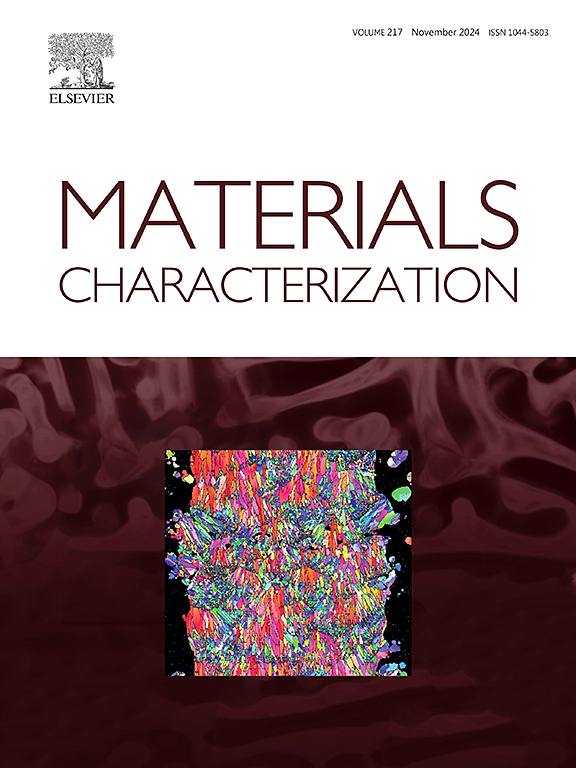Microstructure and properties of Ti-6Al-4V/Ni-Ti heterogeneous structure with CuNi interlayer fabricated by wire-arc directed energy deposition
IF 4.8
2区 材料科学
Q1 MATERIALS SCIENCE, CHARACTERIZATION & TESTING
引用次数: 0
Abstract
The fabrication of a Ti-6Al-4V/Ni-Ti heterogeneous structure encounters significant challenges, primarily owing to the formation of brittle Ti![]() Ni intermetallic compounds (IMCs) at the interface, inducing stress concentration and reducing the interfacial joining strength. To address this issue, the present study employs the wire-arc directed energy deposition technology and introduces a Cu
Ni intermetallic compounds (IMCs) at the interface, inducing stress concentration and reducing the interfacial joining strength. To address this issue, the present study employs the wire-arc directed energy deposition technology and introduces a Cu![]() Ni interlayer to optimize the interfacial microstructure and mechanical properties. The results indicate that the Cu
Ni interlayer to optimize the interfacial microstructure and mechanical properties. The results indicate that the Cu![]() Ni interlayer effectively suppresses the formation of brittle Ti
Ni interlayer effectively suppresses the formation of brittle Ti![]() Ni IMCs and promotes the formation of Ti
Ni IMCs and promotes the formation of Ti![]() Cu and Ti-Ni-Cu phases, thus enhancing the interfacial strength. The microhardness of the interlayer attains a value of 570 HV0.2, while the as-built wall achieves an average ultimate tensile strength of 279.9 ± 15 MPa and a strain of 5.6 % ± 2 %. The developed strategy is effective for the interfacial optimization of heterogeneous structures and has significant potential for applications in the aerospace industry.
Cu and Ti-Ni-Cu phases, thus enhancing the interfacial strength. The microhardness of the interlayer attains a value of 570 HV0.2, while the as-built wall achieves an average ultimate tensile strength of 279.9 ± 15 MPa and a strain of 5.6 % ± 2 %. The developed strategy is effective for the interfacial optimization of heterogeneous structures and has significant potential for applications in the aerospace industry.
线弧定向能沉积制备Ti-6Al-4V/Ni-Ti非均相CuNi夹层结构的组织与性能
Ti-6Al-4V/Ni-Ti非均相结构的制备面临着巨大的挑战,主要是由于在界面处形成脆性的TiNi金属间化合物(IMCs),引起应力集中,降低了界面连接强度。为了解决这一问题,本研究采用线弧定向能沉积技术,并引入CuNi夹层来优化界面微观结构和力学性能。结果表明,CuNi夹层有效抑制了脆性TiNi IMCs的形成,促进了TiCu和Ti-Ni-Cu相的形成,从而提高了界面强度。中间层的显微硬度达到570 HV0.2,而筑墙的平均极限抗拉强度为279.9±15 MPa,应变为5.6%±2%。该策略对非均质结构的界面优化是有效的,在航空航天工业中具有重要的应用潜力。
本文章由计算机程序翻译,如有差异,请以英文原文为准。
求助全文
约1分钟内获得全文
求助全文
来源期刊

Materials Characterization
工程技术-材料科学:表征与测试
CiteScore
7.60
自引率
8.50%
发文量
746
审稿时长
36 days
期刊介绍:
Materials Characterization features original articles and state-of-the-art reviews on theoretical and practical aspects of the structure and behaviour of materials.
The Journal focuses on all characterization techniques, including all forms of microscopy (light, electron, acoustic, etc.,) and analysis (especially microanalysis and surface analytical techniques). Developments in both this wide range of techniques and their application to the quantification of the microstructure of materials are essential facets of the Journal.
The Journal provides the Materials Scientist/Engineer with up-to-date information on many types of materials with an underlying theme of explaining the behavior of materials using novel approaches. Materials covered by the journal include:
Metals & Alloys
Ceramics
Nanomaterials
Biomedical materials
Optical materials
Composites
Natural Materials.
 求助内容:
求助内容: 应助结果提醒方式:
应助结果提醒方式:


